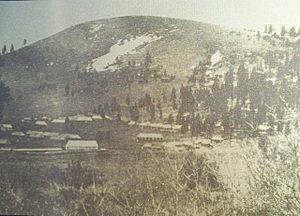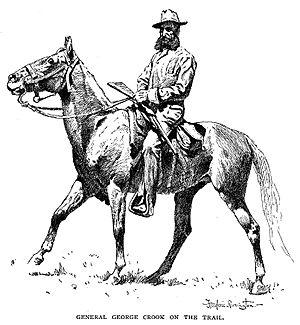Camp Warner facts for kids
Quick facts for kids Fort Warner |
|
|---|---|
| Lake County, Oregon, U.S.A. | |

Fort Warner near Honey Creek in 1873
|
|
| Coordinates | 42°25′49″N 119°43′45″W / 42.43025°N 119.72926°W 42°23′54″N 120°08′16″W / 42.39839°N 120.13767°W |
| Type | Military cantonments |
| Site information | |
| Owner | U.S. Government (Old Camp Warner); private property (Fort Warner) |
| Site history | |
| Built | Old Camp Warner, 1866; Fort Warner, 1867 |
| Built by | United States Army |
| In use | 1866–1874 |
Camp Warner was a United States Army base in south-central Oregon, U.S.A. It was located at two different spots about 35 miles (56 km) apart. The Army called both places Camp Warner. However, the first spot became known as Old Camp Warner. It was used as a winter camp in 1866–1867 and then left empty.
The second, more developed spot is usually called Fort Warner (or New Camp Warner). The Army never officially named it a fort. Fort Warner was used to store supplies and as a main office from 1867 to 1874. This was during a long Army fight against some Northern Paiute groups in Eastern Oregon and Northern California. Today, nothing is left of either Old Camp Warner or Fort Warner.
Contents
Why Was Old Camp Warner Built?
In 1865, the Army decided it needed a base in the Warner Valley of south-central Oregon. This base would help stop Native American groups who were raiding through the area. Army scouts from Fort Vancouver chose a spot along Honey Creek. This was on the west side of the Warner Lakes in what is now Lake County, Oregon.
In 1866, soldiers from the 14th Infantry Regiment were sent from Fort Boise to build the base. They came by way of Fort Harney. They arrived on the east side of the Warner Lakes in late summer. The Army could not cross the Warner Lakes. This is a chain of lakes and wetlands that stretches over 70 miles (110 km) north to south.
So, the soldiers decided to build their base 20 miles (32 km) east of the lakes. This was on the eastern slope of Hart Mountain. It was finished on August 10, 1866. The base was named Camp Warner after Captain William H. Warner. He was an Army engineer who had explored the area. He was killed by Native Americans in 1849.
Life at Old Camp Warner
The camp was quickly built at a high elevation of 6,171 feet (1,881 m). It was not good for the very cold winters common in Oregon's high desert. Because of this, the soldiers had a very hard winter. People said it was so cold inside the camp buildings that the whole group had to march around the parade ground all night to stay warm. One sergeant froze to death during a winter snowstorm.
Why Was Fort Warner Built?
In the spring of 1867, a company of the 23rd Infantry Regiment replaced the 14th Infantry. In February, General George Crook visited Camp Warner. Crook ordered that the camp be moved to the Honey Creek spot. This was west of the Warner Lakes.
To get the Army's wagons and gear across the wetlands, forty men were given a job. Led by Captain James Henton, they had to build a bridge. This bridge would cross a narrow, marshy channel between Hart Lake and Crump Lake. The bridge was built between May 16 and July 24, 1867.
The Stone Bridge
This bridge was known as the Stone Bridge. It was actually a quarter-mile long causeway. Soldiers built it by bringing basalt boulders and smaller rocks from nearby Hart Mountain. They then dumped them into the marsh. Soon after they started the bridge, Crook sent another group ahead. Their job was to build the new camp. On July 31, 1867, the Army moved into the new camp.
Initially, General Crook wanted to name the new base Camp Wood. However, on August 28, 1867, Major General Henry W. Halleck disagreed. He was the commander of the Military Department of the Pacific. He suggested keeping the name Camp Warner. The soldiers at the base called it Fort Warner. This was to tell it apart from the first Camp Warner, which was only 35 miles (56 km) away. Even though the Army never officially called it a fort, the base became widely known as Fort Warner. Today, most modern maps, including United States Geological Survey topographical maps, show the site as Fort Warner.
Fort Warner was on the west side of the Warner Valley. It was in a pine forest 15 miles (24 km) from the lakes. The new spot had a large freshwater spring. It also had enough good timber to build a sawmill. This allowed the soldiers to build strong timber barracks for 280 troops. They also built officer's homes, warehouses, and other buildings.
Also, Fort Warner was about 500 feet (150 m) lower than Old Camp Warner. So, they expected milder winters at the new place. However, the elevation at Fort Warner was still 5,678 feet (1,731 m) above sea level. This meant winters were still quite harsh.
Fort Warner's Role and End
Fort Warner was an Army supply base and main office from 1867 until 1874. During the first two years, General Crook led soldiers from the 1st Cavalry Regiment and 8th Cavalry Regiment. He also had mounted infantry from the 9th Infantry Regiment and 23rd Infantry Regiment. Native American scouts from the Wasco and Warm Springs tribes also helped.
Crook led a successful campaign against Northern Paiute groups in Eastern Oregon and Northern California. This was part of a conflict called the Snake War. Fort Warner was one of several bases used to get new gear and supplies for Crook's troops during the campaign. Mrs. Crook and several other military wives arrived in 1867. They made Fort Warner their home.
By 1869, the Native American raids in south-central Oregon had stopped. A peace treaty had been signed with Wewawewa, the chief of the main Paiute group in the area. In 1872, D Company of the 21st Infantry Regiment was stationed at Fort Warner. However, with no Native American raiders left, Fort Warner was abandoned on September 3, 1874.
Historic Sites Today
Today, very little is left to show that the Army was at Old Camp Warner or Fort Warner. The original Camp Warner site is now part of the Hart Mountain National Antelope Refuge. There is almost nothing left to mark the camp, except for two Army graves.
The Fort Warner site is on a privately owned ranch next to Fremont National Forest. No Army buildings remain at the Fort Warner location. But you can still see the outlines where structures once stood. While nothing remains at either military site, the Stone Bridge the Army built to cross the Warner wetlands still exists. It is listed on the National Register of Historic Places.


